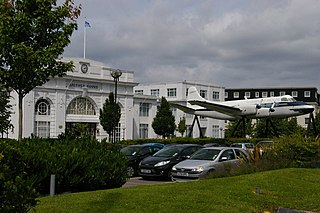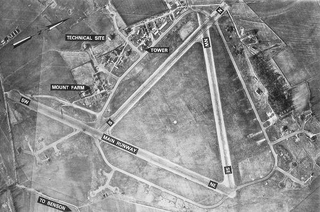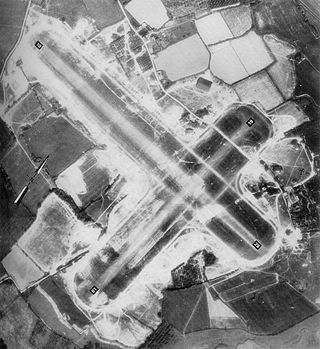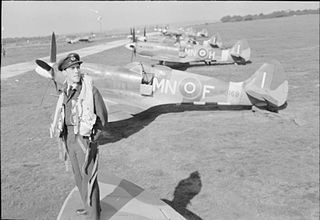
Croydon Airport was the UK's only international airport during the interwar period. Located in Croydon, South London, England, it opened in 1920, built in a Neoclassical style, and was developed as Britain's main airport, handling more cargo, mail, and passengers than any other UK airport at the time. Innovations at the site included the world's first air traffic control and the first airport terminal. During World War II the airport was named RAF Croydon as its role changed to that of a fighter airfield during the Battle of Britain; and in 1943 RAF Transport Command was founded at the site, which used the airport to transport thousands of troops into and out of Europe.

London Biggin Hill Airport is an operational general aviation airport at Biggin Hill in the London Borough of Bromley, located 12 NM south-southeast of Central London. The airport was formerly a Royal Air Force station RAF Biggin Hill, and a small enclave on the airport still retains that designation.

The Handley Page HP.67 Hastings is a retired British troop-carrier and freight transport aircraft designed and manufactured by aviation company Handley Page for the Royal Air Force (RAF). Upon its introduction to service during September 1948, the Hastings was the largest transport plane ever designed for the service.
Royal Air Force Manston or more simply RAF Manston is a former Royal Air Force station located in the north-east of Kent, at grid reference TR334663 on the Isle of Thanet from 1916 until 1996. The site was split between a commercial airport Kent International Airport (KIA), since closed, and a continuing military use by the Defence Fire Training and Development Centre (DFTDC), following on from a long-standing training facility for RAF firefighters at the RAF Manston base. In March 2017, RAF Manston became the HQ for the 3rd Battalion, Princess of Wales Royal Regiment (PWRR).

The Scottish Aviation Twin Pioneer was a British STOL transport aircraft built by Scottish Aviation Limited at Prestwick Airport, Scotland, during the 1950s. It was designed for both civil and military operators. It was conceived as a twin-engined version of the Pioneer light transport. Both aircraft required "an area only 30m (99ft) by 275m (902ft) in which to operate."

Royal Air Force East Fortune, or more simply RAF East Fortune, is a former Royal Air Force station located just south of the village of East Fortune. It is a short distance east of Edinburgh, in Scotland. RAFEast Fortune was used as a fighter station during the First World War and later used by a night fighter operational training unit during the Second World War. The motto of the station is "Fortune Favours the Bold".

Royal Air Force Tibenham or more simply RAF Tibenham is a former Royal Air Force station located 13.5 miles (21.7 km) southwest of Norwich and 5.8 miles (9.3 km) north of Diss, Norfolk, England.

Royal Air Force Station Mount Farm or more simply RAF Mount Farm is a former Royal Air Force station located 3 miles (4.8 km) north of Dorchester, Oxfordshire, England.

The Farman F.60 Goliath was a French airliner and bomber produced by the Farman Aviation Works from 1919. It was instrumental in the creation of early airlines and commercial routes in Europe after World War I.

Royal Air Force Staplehurst or more simply RAF Staplehurst is a former Royal Air Force Advanced Landing Ground located in Kent, England. The airfield is located approximately 1 mile (1.6 km) northeast of Staplehurst; about 38 miles (61 km) southeast of London.

The de Havilland DH.34 was a single engined British biplane airliner built by the de Havilland Aircraft Company in the 1920s. 12 were built, with the DH.34 serving with Imperial Airways and its predecessors for several years.
Air Union was a French airline established January 1, 1923, as the result of a merger between the airlines Compagnie des Messageries Aériennes and Compagnie des Grands Express Aériens. Air Union was merged with four other French airlines to become Air France on 7 October 1933.
Lympne Airport, was a military and later civil airfield, at Lympne, Kent, United Kingdom, which operated from 1916 to 1984. During the First World War RFC Lympne was originally an acceptance point for aircraft being delivered to, and returning from, France but was later designated as a First Class Landing Ground, RAF Lympne. It became a civil airfield in 1919 and saw the operation of early air mail services after the 1918 armistice. It was one of the first four airfields in the United Kingdom with customs facilities.

Royal Air Force Lympne or more simply RAF Lympne is a former Royal Air Force satellite station in Kent used during the First and Second World Wars. It was opened in 1916 by the Royal Flying Corps as an acceptance point for aircraft being delivered to, and returned from, France. It was later designated as a "First Class Landing Ground". In 1919, the airfield was turned over to civil use as Lympne Airport, serving until 1939 when it was requisitioned by the Fleet Air Arm as HMS Buzzard, later being renamed HMS Daedalus II.

Penshurst Airfield was an airfield in operation between 1916–36 and 1940–46. Initially a military airfield, after the First World War it was used as an alternate destination to Croydon Airport, with some civil flying taking place. The airfield closed following the crash of a Flying Flea at an air display in 1936, and was converted to a polo ground.

The 1930 Air Union Farman Goliath crash occurred on 10 February 1930 when a Farman F.63 Goliath of Air Union crashed whilst attempting an emergency landing at Marden Airfield, Kent following the failure of the starboard tailplane. Two of the six people on board were killed.

The Great West Aerodrome, also known as Harmondsworth Aerodrome or Heathrow Aerodrome, was a grass airfield, operational between 1930 and 1944. It was on the southeast edge of the hamlet of Heathrow, in the parish of Harmondsworth. The Fairey Aviation Company owned and operated it, for assembly and flight testing of Fairey-manufactured aircraft. The area was to later be the site of London Heathrow Airport.
Royal Air Force Bitteswell or more simply RAF Bitteswell is a former Royal Air Force satellite station located 2.0 miles (3.2 km) west of Lutterworth, Leicestershire and 6.1 miles (9.8 km) north of Rugby, Warwickshire, England.

Bekesbourne Aerodrome was an airport located at the southeast edge of the village of Bekesbourne, southeast of Canterbury, Kent. It operated from 1916 until 1940, and had both military and civil roles.















